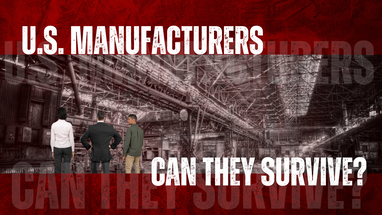Jun 19th 2025
Robotics Now Required to Stay Globally Competitive
Whether it's rising labor costs, global competition, or systemic workforce shortages, maintaining competitiveness demands bold action. One truth stands clear: the widespread adoption of robotics—especially collaborative robots (cobots)—is no longer optional—it’s essential.
Despite persistent fears that robots will “take jobs,” the reality is quite the opposite. Cobots are stepping in to fill roles where human turnover is high, enabling manufacturers to stabilize operations and redirect employees to more meaningful and higher-value work.
Labor Shortages: A Permanent Shift
The U.S. manufacturing sector faces a deep structural labor gap: Deloitte projects 2.1 million unfilled manufacturing roles by 2030. The roles that cobots typically fill—such as machine tending, pick-and-place, packaging—see employees staying only 9–18 months on average due to fatigue, lack of growth, and job dissatisfaction. Cobots take over where people don’t stay.
Global Rivals Are Accelerating
Countries like South Korea, Germany, and China have far higher robot density (e.g., South Korea has over 1,000 robots per 10,000 manufacturing workers). They benefit from lower costs, higher quality, and faster production cycles, leaving U.S. manufacturers behind.
Reshoring Requires Automation
Returning manufacturing to U.S. soil is a trend—yet reshoring is only viable if factory productivity is high. Robotics allows domestic firms to match offshore cost structures by boosting throughput, minimizing defects, and shortening lead times.
Modern Robots Are Accessible
Collaborative robots today are:
- Safe to work alongside humans
- Quick and easy to program
- ROI-achievable within 6–12 months
- Well-suited for low-volume, high-mix operations
This democratizes access beyond large enterprises to small and mid-sized manufacturers.
Robots Redefine Jobs—They Don’t Eliminate Them
Cobots free workers from repetitive, unsafe tasks and allow them to transition into more skilled, fulfilling roles like:
- Cobot programming and maintenance (Get FREE Universal Robots Cobot training here)
- Quality assurance and continuous improvement
- Logistics, engineering, and supervisory positions
Robots don’t take jobs—they elevate work.
Grants & Funding to Supercharge Adoption
To make automation more affordable and accessible, many states and the federal government now offer generous grant programs:
- Maryland Manufacturing 4.0
– Grants of $25K–$500K, covering 25–75% of project costs (dependent on firm size), for robotics, automation, digital manufacturing systems (commerce.maryland.gov, earlbeck.com). - Michigan MEDC Industry 4.0 Implementation Grant
– Matching grants up to $25K (50% reimbursement) for adoption of robotics, automation, AI, cybersecurity (mgalliance.org). - New Jersey Manufacturing Voucher Program (NJ MVP)
– Covers 30–50% of equipment costs, up to $250K, plus bonuses for small, woman-/minority-/veteran-owned and unionized firms (njeda.gov). - Connecticut Strategic Supply Chain Initiative
– Grants from $500K to $5M, matching at least 50% (10% in distressed areas), for equipment purchases and tech upgrades (including robotics) (portal.ct.gov).
These programs inject public investment into private innovation, accelerating adoption and enabling U.S. firms to compete on both cost and quality.
Final Takeaways - Insights & Why They Matter
- Jobs are being filled—but they’re not sticking: Cobots stabilize labor without destroying careers.
- Global rivals are automating fast: U.S. lagging in robotics density hurts our competitive edge.
- Reshoring demands productivity: Robotics bridges the cost gap of domestic manufacturing.
- Grants and funding reduce risk: State/federal programs cover 25–75% of automation costs.
- Robots elevate the workforce: Automation empowers workers to perform higher-level roles.
Your Next Steps
- Identify repetitive or high-turnover tasks in your plant.
- Explore state/federal programs—see eligibility and deadlines.
- Launch a pilot project using a grant to offset costs.
- Track ROI and workforce impact, then scale up.
Adopting robotics isn’t about eliminating jobs—it’s about eliminating inefficiency and uncertainty. It empowers U.S. manufacturers and their workforces to thrive globally.
Need help navigating these grant programs or planning your automation roadmap? Contact us today!

